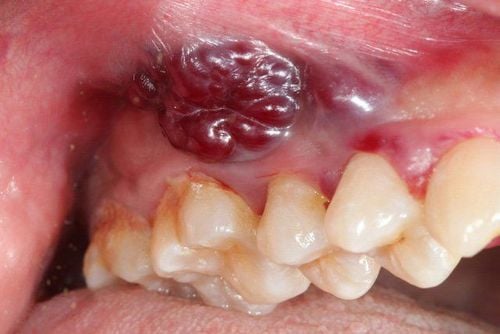This is an automatically translated article.
The article was consulted with Dr. To Kim Sang - Oncology Center, Vinmec Central Park International General Hospital.Head and neck cancer is a term used to describe several types of malignant tumors that develop in and around the throat, larynx, nose, sinuses, and mouth.
1. What is head and neck cancer?
Cancer begins when cells change and grow out of control, forming tumors. Tumors can develop into cancer or be benign. A malignant tumor means that it can grow and spread to other parts of the body. A benign tumor can also grow, but it does not spread to other parts of the body.Most head and neck tumors are squamous cell carcinomas (squamous cell carcinomas), which are the cells on the surface of the lining of the head and neck. If the cancer is found only in the squamous cell layer, it is called carcinoma in situ. If the cancer grows beyond the squamous cell layer, passes through the basement membrane, and penetrates deeply, it is called invasive carcinoma.
The cause of head and neck cancer can be attributed to the habit of using tobacco and alcohol. Tobacco and alcohol are considered two high risk factors for this cancer. In addition, the human papillomavirus (HPV) also increases the risk of head and neck cancer. Besides, factors such as poor oral hygiene, eating betel nut or using preserved or salted foods for a long time, radiation exposure are risk factors for head and neck cancer.

Trắc nghiệm: Thử hiểu biết của bạn về bệnh ung thư
Ung thư là nguyên nhân gây tử vong hàng thứ 2 trên thế giới. Thử sức cùng bài trắc nghiệm sau đây sẽ giúp bạn có thêm kiến thức về yếu tố nguy cơ cũng như cách phòng ngừa bệnh ung thư.
Bài dịch từ: webmd.com
2. Classification of head and neck cancer
Head and neck cancers are named for the part of the body where they develop. However, the most common types of head and neck cancer include:2.1 Laryngeal and hypopharynx cancer The larynx contains the vocal cords and is often considered the source of sound. The larynx is a tubular structure located inside the neck, formed by cartilage just below the pharynx. It has an organ called the epiglottis, which moves and covers the larynx to prevent food from entering the airways. The larynx plays an important role in breathing, speaking and swallowing.
Cancer can develop in any part of the larynx or hypopharynx. Approximately 95% of all cancers of the larynx and pharynx are classified as squamous cell carcinomas. Laryngeal and hypopharynx cancers are two of the main cancers in the head and neck region.
People with cancer of the larynx or pharynx may experience symptoms or signs such as: hoarseness or voice changes that do not go away within 2 weeks; enlarged lymph nodes or lumps in the neck; airway obstruction, difficulty breathing; persistent sore throat or a feeling that something is stuck in the throat; difficulty swallowing that does not go away; ear hurt; chronic bad breath, choking; unexplained weight loss; tired.

* Melanoma is a malignant tumor that develops from cells called melanocytes, which give the skin its color. It is usually an invasive, fast-growing cancer.
* Invert papilloma. These are initially benign, wart-like growths that can develop into squamous cell carcinoma. About 10% to 15% of these will develop into cancer.
* Olfactory neuroblastoma: This type of cancer involves the nerves that control the sense of smell. It occurs on top of the nasal cavity and involves a structure called the cribriform. The ethmoid plate is a bone located deep in the skull between the eye and the sinus. This type of cancer looks similar to neuroblastoma.
* Lymphoma is a cancer of the lymphatic system that can develop in the lymphatic tissue found in the lining of the nasal cavity and paranasal sinuses.
* A sarcoma is a cancer that starts in muscle, connective tissue, or bone. Cancer develops from the mesenchymal layer of the body.

Possible signs of nasopharyngeal cancer: stuffy nose; Difficulty hearing or hearing loss; The feeling of fullness or pain in the ear is caused by fluid buildup in the middle ear, especially if it doesn't go away and occurs in only 1 ear; Pain and tinnitus; A sore throat that doesn't seem to go away; Difficulty breathing or speaking Frequent nosebleeds,...
2.4 Oral cavity Cancer The oral cavity (oral cavity) includes the lips, the anterior two-thirds of the tongue, the gums, the oral vestibule and the buccal mucosa (inner lining of the cheeks and lips), floor of the mouth (the lower part of the mouth of the mouth) ), the hard palate (top of the mouth bone), and the posterior triangle (the small area of gum behind the wisdom teeth).
Oral cancer and oropharyngeal cancer are two of the most common cancers that develop in the head and neck area. More than 90% of oral and oropharyngeal cancers are squamous cell carcinomas. The most common sites for cancer in the oral cavity are: tongue, gums, floor of the mouth.

Both benign and cancerous tumors can start in any large or small salivary gland. Most tumors develop in the parotid gland, and about half of the tumors in the submandibular gland are benign. Sublingual gland tumors are usually cancerous.
Sometimes other types of cancer such as skin cancer can spread to the salivary glands or to nearby lymph nodes located in and around the parotid gland and next to the parathyroid gland.
Some other types of cancer can also be found in the head and neck area, but will be diagnosed and treated differently than the cancers listed above. The signs of head and neck cancers may not be detected until they cause problems that prompt a visit to the doctor. If a patient is diagnosed with head and neck cancer, the doctor will learn the extent of the disease to assess the stage of the disease and plan treatment for the patient. The cancer stage can be stage 0, 1, 2, 3, or 4. The higher the stage, the more the cancer has spread. Current treatments for head and neck cancer typically include surgery, radiation therapy, chemotherapy, immunotherapy, and targeted therapy.
Vinmec International General Hospital is one of the hospitals that not only ensures professional quality with a team of leading medical professionals, modern equipment and technology, but also stands out for its examination and consultation services. comprehensive and professional medical consultation and treatment; civilized, polite, safe and sterile medical examination and treatment space. In particular, the system of modern and high-quality radiotherapy machines allows the hospital to perform modern radiotherapy techniques such as dose-modulated radiation therapy (IMRT), arc-volume modulated radiotherapy (VMAT). ),...

- Free specialist examination and discount 50% discount on many cancer screening packages
- Reduce 50% of costs for customers with indications for post-examination treatment. The program is limited to the corresponding technique of each hospital and to customers who perform this treatment technique for the first time at Vinmec.
Please dial HOTLINE for more information or register for an appointment HERE. Download MyVinmec app to make appointments faster and to manage your bookings easily.
The article references the source: Cancer.gov, Cancer.net












